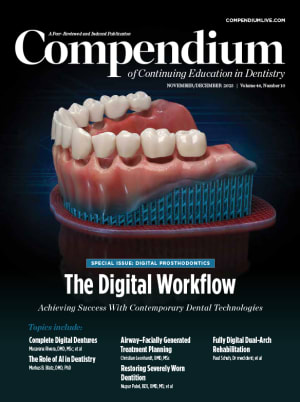Starting a New Journey: Billing Medical Insurance
Oral physicians can enhance their comprehensive treatment by filing medical benefits, even if they remain a fee-for-service practice.
Patients are increasingly aware of the oral–systemic connection and are seeking financial support from their medical plans. Advances in medical insurance billing for dental patients include CBCT, bone grafts, implants, sleep apnea, and other procedures. Oral physicians can enhance their comprehensive treatment by filing medical benefits, even if they remain a fee-for-service practice. It is important to know why to bill medical insurance, when to file for medical instead of dental, and how to start and simplify the process.
Bridging the Gap
The 2000 US Surgeon General’s report Oral Health in America highlighted the link between oral and general health.1 Oral exams can show signs of immunologic diseases, endocrinopathies, hematologic conditions, systemic infections, and nutritional disorders. Studies have also linked periodontal disease with diabetes, heart disease, stroke, and adverse pregnancy outcomes. Early diagnosis and treatment can be achieved by recognizing oral symptoms.
Informed patients are now requesting medical billing for dental procedures to reduce financial costs. Dental professionals must navigate medical benefits and ensure diagnoses meet medical necessity criteria. This approach can improve patient care and collaboration with medical providers, helping to bridge dental and overall health. Accurate documentation and knowledge of medical policies are crucial, especially in cases requiring medical intervention over dental procedures.
Initiating the Process
The clinician first needs to verify the patient’s medical benefits to understand coverage and out-of-network options. If satisfactory, reimbursement expectations can be discussed. Then, chief complaints, exam findings, and diagnoses are documented in SOAP (subjective, objective, assessment, and plan) format to complete the medical claim. Software can be used to simplify this process, and many practices outsource billing to save time and focus on patient care.
Medical plan policies detail coverage criteria for treatments. For patients with functional impairments who cannot tolerate dentures and require soft or liquid food, other billable procedures include examinations, radiographs, frenectomies, mucositis treatment, myofascial pain dysfunction treatment (eg, Botox®), third molar extractions, obstructive sleep apnea and temporomandibular joint appliance therapy, bone grafts, and implants. Clinicians should read the policy contract before engaging in medical billing and collaborate with the medical provider for billing purposes. It helps to know exact codes, medication names, and patient risk scores.
An example is “subjective complaints medical policy”: Oral implants may be covered if trials of a mandibular prosthesis fail and there are issues like malnutrition, a diet limited to soft foods, persistent pain, mucosal hypertrophy, or upper intestinal problems.
Procedures are deemed “medically necessary” if they address significant functional impairment and can improve it. The clinician’s documentation and collaboration with a medical provider will help in getting the procedure covered. “Reconstructive” procedures are those that are intended to correct a significant deviation from normal life due to injury, disease, trauma, treatment of a disease, or congenital defect. Clinicians should note that not all benefit contracts/certificates cover reconstructive services. Benefit language takes precedence.
Mandibular/maxillary (orthognathic) surgery, for example, is considered medically necessary to treat a significant functional impairment when the procedure can be expected to improve the functional impairment. Significant functional impairment may include dysphagia, speech abnormalities, intraoral trauma while chewing related to malocclusion, and masticatory dysfunction or malocclusion. Each condition has certain criteria that must be met. For example, for dysphagia, several criteria related to difficulty chewing must be met, and symptoms must be documented in the medical record, be significant, and persist for at least 4 months; other causes of swallowing or choking problems must have been ruled out by history, physical examination, and appropriate diagnostic studies. For a speech abnormality, the condition must be determined by a speech pathologist or therapist to be due to a malocclusion and was not able to be helped by orthodontia or at least 6 months of speech therapy. Masticatory dysfunction requires total bilateral maxillary palatal cusp to mandibular fossa discrepancy of 4 mm or greater, or a unilateral discrepancy of 3 mm or greater, given normal axial inclination of the posterior teeth.
Documentation Is Key
Clinicians should document why the treatment is needed and the outcome. If there is a medical reason, it is best to ensure the medical doctor understands the diagnostic reasons and believes the treatment is necessary.
Complete or partial tooth loss should be documented, with atrophy matched to diagnostic causes such as bone loss, infection, or other major medical conditions to support the findings. Clinicians should learn how to use the SOAP format for documentation and understand the reasons medical providers are referring patients to oral health providers. A helpful article for dental practitioners is “Dental Problems in Primary Care,”2 which informs medical professionals about oral collaboration. A free online tool for risk assessments for clinicians is available at www.previser.com.
Conclusion
Embracing medical insurance billing in dental practice helps bridge the gap between oral and systemic health, enhances patient care, and improves access to necessary treatments. By understanding coverage criteria, documenting accurately, and collaborating with medical providers, clinicians can better support their patients’ health while navigating the evolving, and sometimes complicated, landscape of integrated healthcare.
About the Author
Christine Taxin
President, Links2Success (links2success.biz), a practice management consulting company to the dental and medical fields; Adjunct Professor, New York University College of Dentistry, New York, New York
